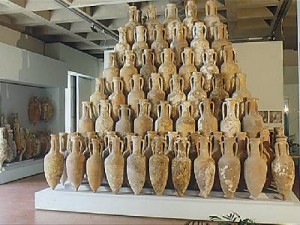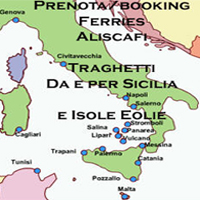
SECTION I
It is located in the ancient palace of the bishops, next to the Cathedral, built in the seventeenth century. Materials of the excavations of the Acropolis of Lipari
ROOM I – On display are the materials of the two older stages of the Neolithic Eoliano.
ROOM II – Materials of the third and fourth phase of the Neolithic Eoliano.
ROOM III – Materials of the fourth phase of the Neolithic Eoliano.
ROOM IV – Neolithic Eoliano.
ROOM V – Late Neolithic.
ROOM VI – First Bronze Age: Culture of Capo Graziano, Middle Bronze Age: Culture of Milazzese. Local pottery imports Aegean.
DOWNSTAIRS
ROOM VII – Late Bronze Age. First phase of Ausonia culture (1250-1150 BC)
ROOM VIII – Final Bronze Age culture-Second phase of Ausonia (1150-850 BC).
ROOM IX – end of the second period of civilization Ausonia (late ninth century BC). The village dell’Ausonio II suffered a violent destruction. The huts burned (evident in the excavation traces of the fire) collapsed burying all the household they contained. One gets the impression that after this destruction the village has not been rebuilt.
ROOM X – Evidence of Greek and Roman civilization in the urban area of Lipari. From ROOM X, a wall of which is formed by the remains of the Norman palace built with blocks riadoperati Greek, descend into the garden below, where there are other remains of the same building and visit:
ROOM XI – Hall epigraphic (there are collected stones and stems recorded from the tombs in the necropolis of Lipari from the fifth century BC. Roman times).
Section II
It is located in front of the bishop’s palace (ROOMS XII-XV) with archaeological materials of the islands of Panarea, Filicudi, Alicudi, Salina, Stromboli.
Section III, Section IV and Section V
It is located in a different building to the north of the cathedral with the protohistoric necropolis and classical Lipari, prehistory and early history of Milazzo, and marine archeology. Are divided as follows:
ROOMS XVI and XVII – Materials archaeological Milazzo.
ROOM XVI (bottom)-Necropolis of the Middle Bronze Age found in the district Sottocastello (XIV-XIII century BC.). The necropolis was rebuilt exactly as it was found during the excavations of May 1952. Only some of the tombs on the margins were very close to the main group.
ROOM XVII – proto Necropolis (XI-XII century BC) and necropolis protogreca (716-580 BC) discovered around the Piazza Roma and Via XX Settembre.
ROOM XVIII – There has been faithfully reconstructed the necropolis of the early dell’Ausonio II Lipari found in the excavations of the Piazzetta Monfalcone, in the center of the modern city, in 1953.
ROOM XIX – We are the main types of coffins, cinerary pots, large pots containing the funeral, memorial stones and stems of the great Greek and Roman necropolis of Lipari.
UPSTAIRS
ROOMS XX-XXV – Greek and Roman Necropolis of Lipari in the Diana. The excavations of Greek and Roman necropolis of Lipari exploring tombs around 2500, led to the Aeolian Museum a large number of works of art, especially ceramics and terracotta figures. The first graves are a little later to the founding of the Greek colony (580 BC). Graves that have kits richest are those of the fourth century BC. In the first half of this century belongs to a crater with a representation of an episode of the Odyssey. Ulysses reached the land of Cicones receives from Maron, a priest of Apollo, the bottle of wine, which will help the Cyclops drunk Polifemo. In the second half of the fourth century, blooms in a school Lipari local pottery. Feature of this school is the extensive use of polychromy, which due to the favorable soil conditions, it is often very well preserved. Lipari in the middle of the fourth century BC flourishes a lively terracotta which draws its favorite topics from contemporary theater. This is attested by a large number of clay models of theatrical masks of this age.
HALL XXIV is exposed the result of excavations carried out in a small sanctuary dedicated to Demeter and Kore dug in the Diana.
HALL XXV is reconstructed true to a group of tombs in the necropolis. With its polychrome ceramic and terracotta its Lipari is revealed in the fourth century. B.C. one of the most vibrant art centers and individual of Greece in the West and in some ways the most spiritually close to southern Italy that the Sicilia.Ritornando the ground floor, before leaving you visit ROOM XXVI of marine archeology. They are exposed to material from the underwater research conducted on the last thirty years in the Aeolian archipelago. Of great interest are the prehistoric pottery style of Capo Graziano I (XVI-XVII century BC.) Recovered in the bay of Lipari.
A little more recently a fragment of an amphora yoke Mycenaean age (XV-XVI sec.aC). Amphorae from shipwrecks IV sec. B.C.
Cape Graziano Filicudi and the fourth century. B.C. the Ants of Panarea.Grande complex of amphorae and black-glazed ceramics (IV-III century BC.) from the cargo of a ship wrecked at Cape Graziano Filicudi.
Big complex of amphorae and black-glazed ceramics (Campana A) that made up the loading of a cargo ship sank in the shallows of Lipari (half sec.aC III). Grande complex of amphorae and black-glazed ceramics (Campana B) the load of a cargo ship wrecked at Cape Graziano Filicudi (half III BC).
Amphorae of the Roman imperial period to another wreck at Filicudi.Cannoni bronze of a vessel of the late seventeenth or early eighteenth century whose wreck has been superimposed over those of the Greek ships of Filicudi.
In the park surrounding the museum were reconstructed the different types of tombs from the fifth and fourth centuries BC. B.C. found in the necropolis of the Diana.
SECTION GEOLOGICAL-VOLCANOLOGICAL the Aeolian Museum illustrates in graphic, plastic and captions the geological history of the Aeolian Islands and the various episodes through which they have assumed their present form.






